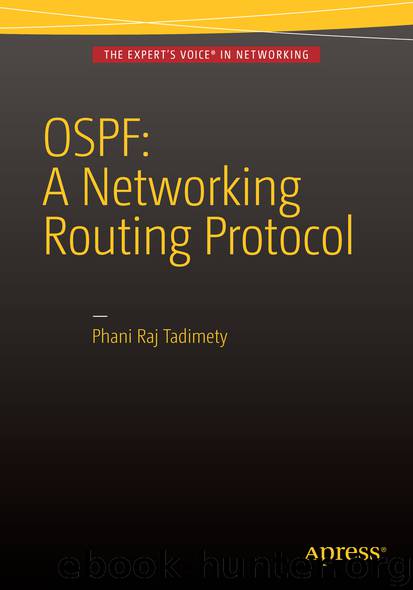OSPF: A Networking Routing Protocol by Phani Raj Tadimety

Author:Phani Raj Tadimety
Language: eng
Format: epub
Publisher: Apress, Berkeley, CA
The Network Numbers
As mentioned, the address of the Bhopal router just discussed is toothfix.genially.bhopal.router/24, with the network prefix as 24. That makes the router’s network number be toothfix.genially.bhopal.0000000/24. Now, there might be some who are puzzled. We have an organizational network with the network number toothfix.genially.0.0/16, with the network prefix length being 16. How does one explain the different network numbers for the same organizational network? The answer is that these numbers identify different networks; that is, one small network is part of a bigger network. It all depends upon one’s perspective.
The toothfix.genially/0.0/16 “parent” organizational network is made up of these smaller networks, or subnetworks (a sub-network is also a network). Hence, the subnetworks have a part of their respective prefixes that is common to all members of that subnetwork—the “parent” enterprise network number. To distinguish one subnetwork from another, the specific subnetwork number is unique at that lower level by adding a few more bits to the common parent network prefix. This results in a longer subnetwork prefix; the subnetwork number for the LAN at Bhopal is, therefore, toothpick.genially.bhopal.0000000/24.
The length of the network prefixes need not be restricted to the boundaries of the dotted decimals in the IP address; that is, they need not be only multiples of eight bits.
Any subnetwork created within the Bhopal subnetwork also will have an identifier added to the “parent” network number that extends the prefix further and makes it distinguishable at that level of the hierarchy. For example, the LAN at Bhopal has three more bits added to its parent Bhopal network prefix, resulting in its own network number of toothfix.genially.bhopal.lan0000/27.
Subnetting
The whole IP addressing scheme is hierarchical in nature and similar to a naming practice supposedly still prevalent in some regions of the world. Names identify common family roots and they trace a hierarchy of related social units. A large community has a common name which is used by its members and that’s how outsiders refer to the community. However the community itself is made of smaller clans who have the practice of adding a clan name to their common community title to distinguish each clan from the others within the community. Then there are family names. As one moves closer to locating an individual you end up with some names as long as an arm. Mine is longer, but for different reasons. I’ll narrate the tragic story behind that some other time.
Download
This site does not store any files on its server. We only index and link to content provided by other sites. Please contact the content providers to delete copyright contents if any and email us, we'll remove relevant links or contents immediately.
Deep Learning with Python by François Chollet(15032)
The Mikado Method by Ola Ellnestam Daniel Brolund(12292)
Hello! Python by Anthony Briggs(12183)
OCA Java SE 8 Programmer I Certification Guide by Mala Gupta(11550)
Dependency Injection in .NET by Mark Seemann(11336)
A Developer's Guide to Building Resilient Cloud Applications with Azure by Hamida Rebai Trabelsi(10530)
Algorithms of the Intelligent Web by Haralambos Marmanis;Dmitry Babenko(10150)
The Well-Grounded Java Developer by Benjamin J. Evans Martijn Verburg(9811)
Grails in Action by Glen Smith Peter Ledbrook(9479)
Secrets of the JavaScript Ninja by John Resig Bear Bibeault(9045)
Hit Refresh by Satya Nadella(9039)
Sass and Compass in Action by Wynn Netherland Nathan Weizenbaum Chris Eppstein Brandon Mathis(9032)
The Kubernetes Operator Framework Book by Michael Dame(8473)
Test-Driven iOS Development with Swift 4 by Dominik Hauser(8437)
Exploring Deepfakes by Bryan Lyon and Matt Tora(8298)
Robo-Advisor with Python by Aki Ranin(8250)
Practical Computer Architecture with Python and ARM by Alan Clements(8225)
Implementing Enterprise Observability for Success by Manisha Agrawal and Karun Krishnannair(8193)
Building Low Latency Applications with C++ by Sourav Ghosh(8098)
